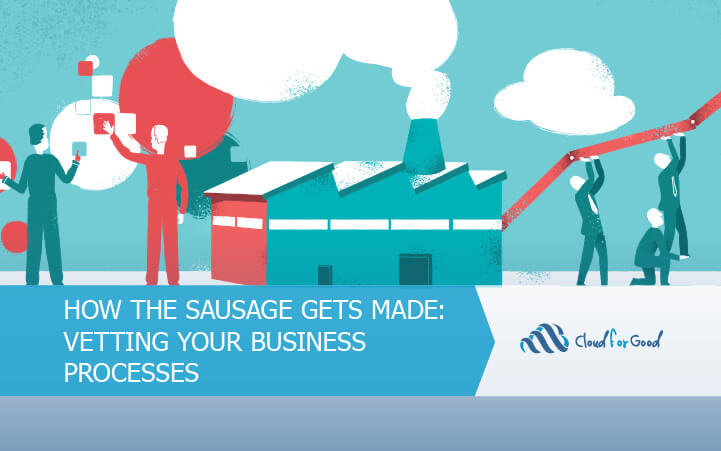I’m a big This American Life fan. Listening to their weekly episode, even if it’s one I’ve heard before, is always a highlight of my week. If you’re not one of the 2.5 million people who download their podcast every week, or if you’re not one of the 2.2 million people who listen to them on the radio, it’s a show by Chicago’s NPR affiliate, WBEZ. On the show, people tell stories—sometimes real stories, sometimes fictional stories, all flawlessly crafted, all organized around a central theme. It’s a racconteur’s dream.
When talking to clients about their business processes, I’m often reminded of episode 241, act 15: Mister Prediction. It’s a short act. You should give it a listen, because my summary won’t do it justice. In a nutshell, a hot dog company moved from a factory that grew over time—a real rat’s nest of haphazardly placed boiling rooms, smoking rooms, refrigeration units, and curing rooms—to a shiny, flawless new factory. They were excited to move into the new facility, thinking it would help them run more efficiently, serve their customers better, make better products, and generally make their lives easier.
If the metaphor isn’t clear yet, your new Salesforce instance is the shiny, new hot dog factory.
Though the company kept their recipe for hot dogs the same, something just didn’t quite translate well. They used the same ingredients, prepared them in the same way, and handled them even better than they had before, but something was off. They were used to their hot dogs having a characteristic bright red color, but they came out an unimpressive pink instead. This was a big problem, but one they couldn’t figure out how to fix until a few workers from the shop met after work for drinks and started talking about a colleague who didn’t want to commute to the new plant, Irving:
He would go through the hanging vents, that’s where we hang the pastrami pieces. And it’s quite warm. And he would go through the boiler room, where we produced all the energy for the plant. He would go next to the tanks where we cooked the corn beef. Finally get around the corner, in some cases actually go up an elevator. And then he would be at the smoke house. He would put it in the smoke house and he would cook it.
All told, Irving’s travels through the labyrinth of the old factory with a tray of uncooked hot dogs took about half an hour, and during that trip the hot dogs would warm up a little before being fully cooked. In their new plant, they would just sit in a cold room before they were finally cooked. That gradual warming before cooking is what gave the hot dogs their characteristic color.
The organization did not fully document their business processes, and did not fully vet them when they moved into a new facility. If your organization sometimes feels like a rodent warren of haphazard business processes, there are some things you can do to make them better. You’re doing more than just making hot dogs, after all.
Ask Why
Business processes have a way of growing organically over time unless they’re closely monitored. Like a garden that doesn’t receive regular attention, they can become overgrown, messy, and confusing. In my role as a consultant, I regularly hear that things are done the way they are done because that is the way they have always been done. While there’s an argument to be made for minimizing rapid, sudden change, inertia is never a good reason to continue to follow a business process.
Think critically about your business processes. Ask why each line of a business process is necessary to follow. What purpose does it serve? How does it move the goals of the organizaiton forward? Also think about the business process as a whole, asking why it exists. You will often find that a single business process has many dependent, connected business processes attached to it, and that many of them are redundant or irrelevant and can be eliminated.
If your business processes aren’t written down, precluding you from going through them line-by-line, well…
Document Everything
It’s extremely important to document your business processes. They should be replicable, step-by-step instructions that do not depend on the any one single person’s historical knowledge to move forward. Nonprofits are constantly reorganizing who is in which position, and the sector as a whole has very high turnover rates. A business process should be written in such a way that someone can pick up a written business process, step through each item in the process, and successfully accomplish a task with limited oversight.
Writing these out is not a trivial activity, but it is important for two reasons: first, it preserves the consistency of the organization’s day to day operations even as staff come and go; second, it gives stakeholders at the organization enough detailed information to begin to think critically about how the organization is spending its time. If a business process is not written down in its entirety, from beginning to end and with every step along the way spelled out, that means your organization is relying upon knowledge that lives in a very small number of heads, and those heads may not stay with your organization forever.
If you aren’t already, start documenting and interrogating your business processes today—don’t find yourself suddenly wondering what to do without Irving.
Looking for more great stuff? You might also enjoy:





